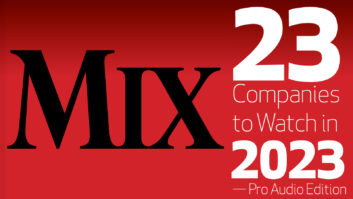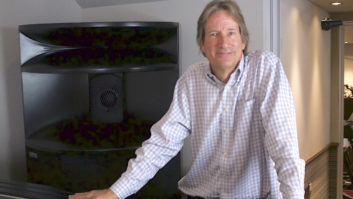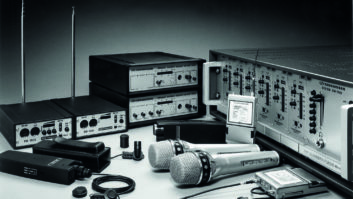One message has become increasingly clear in the studio business during the past decade: Providing conventional recording services is often not enough.
Many of the standard recording studio applications-particularly overdubbing, mixing and mastering-have migrated to alternative venues, such as project studios. At the same time, certain types of sessions, such as voice-overs, needle drops and original music, are increasingly being brought in-house by companies that acquire low-cost, powerful desktop audio equipment.
But when one door closes, others usually open, and the audio business is rife with new opportunities. These include disc replication, computer graphics and artwork design, post-production services, and Internet-based services (a whole article by itself), to name just a few. These services may seem to pull studios away from their core competencies, but they are, in short, adaptive reactions to a changing business environment.
Multimedia? What’s That?Mastering engineer John Trevethan is co-owner, with recording engineer Mike Griffith, of Antarctica, which opened last year in Nashville on the site of the former Sixteenth Avenue Sound on Music Row. “I was right here watching as a studio [business] became increasingly difficult to maintain,” Trevethan says. “The world changed, and some studios couldn’t change with it.”
Antarctica was conceived from the start as serving both music recording and mastering markets. Then Trevethan’s wife, Brenda, moved her Mac G3-based graphics design business into the space, putting out, among other projects, mock renderings of CD covers for the independent recording artists that make up much of the studio’s clientele.
The arrangement works both ways, Trevethan says: “There’s been instances in which her clients have come to the studio for graphics work, and they say, ‘Oh, you have a recording studio here, too…” Brenda Trevethan also does basic Web site design, and the studio adds MP3-encoded audio elements. Antarctica has also developed a flexible rate packaging system: The more services clients use, from recording to mastering to graphics, the larger the discount.
Marketing these services can be tricky, though; the danger, says Trevethan, is in losing focus. “We tried selling ourselves as ‘Antarctica Media’ at one point,” he explains. “But it was too nondescript. People need to know what it is you do, and you have to be able to communicate that information to them as quickly and as simply as you can, because there’s a lot of competition out there.” So, Antarctica incorporated a subtitle into their company name: “Recording, Mastering, Graphics.” Simple yet effective.
Burn, Baby, BurnTape duplication has traditionally been an alternative revenue source for recording studios. Now it’s disc replication. The advent of multi-deck CD-R burner systems, coupled with new compact and equally affordable on-disc printing systems, has made bulk CD replication available to studios. For an investment of less than $10,000, studios can turn out 500 finished discs a day on a multi-disc system from companies such as Otari, Microboards or Rimage. Blank media costs less than $1, therefore this can turn into a significant revenue stream.
But, a note of caution concerning copyrights: While RIAA copyright enforcement has cut into CD piracy and counterfeiting, CD-R pirating has nearly doubled in a year, and both the RIAA and Philips Standards & Licensing-the division of Philips that enforces royalty payments for Philips and its optical disc patent holder partners in CD, CD-R and DVD-are getting much more aggressive-and litigious-in their enforcement efforts. If you do any disc replication for any client, make sure that the client presents you with written assurance that they are the legitimate copyright holders of the material, even if they recorded it in your studio. Both the RIAA and Philips S&L have been suing replicators, and they are aware that studios are offering these services. If you want to get into disc replication in a substantial way, call the RIAA (202/775-0101) and ask for their guidelines for disc replicators. Don’t take this lightly.
Media MoneyAnother less obvious but equally useful idea comes from Advantage Audio in Burbank, Calif., an audio post house specializing in sound for animation. Nearly two years ago, the facility decided to go all-digital, and, ironically, tape sales helped finance that move. According to co-owner Bill Koepnick, the studio had been billing tape costs to clients, coming in at about $200 to $250 of tape per episode, including 2-inch and MDM formats. Instead of selling tape, which then had to be archived, the company began applying those same costs to the use of hard disks, which enabled them to replace hard drives as they wore out. (Work is archived to Exabyte tape, so no projects are ever discarded.) The real benefit, though, comes from the fact that the cost of hard drives has been coming down, with a 9-Gig hard drive now costing less than $900.
“We typically use about the equivalent of eight hard drives per show,” says Koepnick. “But since the cost of the drives is lower, we’re not only replacing the used ones but we’re also able to buy additional ones, thus increasing the amount of media we have available to use for projects. This has helped finance our transition to digital and increased the amount of digital real estate we have, and it’s not costing the client any more than the original analog media was.”
On to the InternetThe Internet presents so many new revenue ideas that I won’t even go into the possibilities here-we’ll devote an entire article to the topic on the next go-around. For now, think of your studio as a site for Webcasts, much the same as you did for radio through the ’90s. And think about sharing files or talent with studios outside your geographical area. Or just let your imagination run wild.
Trouble Ahead: Studio LabelsWe can talk at length about clever ideas to increase the amount of money coming into a studio, but it’s worthwhile to consider what not to do, as well. There are a lot of ideas that look good on paper, or in a bar at 1 a.m. after a couple of cocktails, but implementing those ideas can be a lot less pleasant.
The most-often-cited secondary revenue source for music recording studios is starting a record label. While there have been a few notable successes over the years, and while the Internet and MP3 promise quick returns, for the most part, studio-based record labels don’t make a profit. You may think that you’re using studio time that was available anyway, but the consensus among many studio owners who have gone this route is that projects tend to take on a life of their own and draw producers into using more and more time-billable time. Add in down time costs for electricity and other utilities (ever noticed how much your spec artist spends on the phone?), as well as assistant engineers and runners.
This is not to say that using the studio to pursue personal music ambitions isn’t viable. But it’s worth considering the actual costs of such ventures vs. the potential for return. Even the major record labels cry about how low their batting average is in terms of how many acts they sign vs. how many ever actually hit and make a profit. (It’s an argument they generally trot out whenever anyone points out that the cost of a replicated CD is now less than 30 cents, while the labels are still charging $17.97 for CDs.)
The same jaundiced eye should be brought to bear on spec deals that come from the outside. Trading billable time for a piece of the pie-in-the-sky is questionable business, at best, for all of the foregoing reasons. But if you do decide to participate in a spec deal, get the entire deal on paper (preferably one written by your attorney), don’t undervalue the contribution of your studio to the outcome of the project, and lean toward hard compensation vs. percentages of sales or publishing, which can be easily fudged later.







